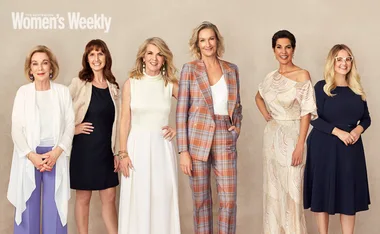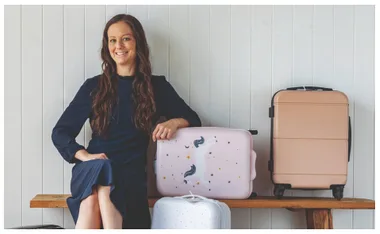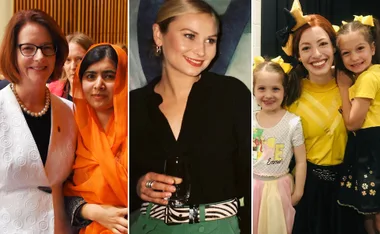Hannah Diviney first came into The Weekly’s orbit in a harbourside hotel room ahead of the Women of the Future luncheon at the Sydney Opera House.
She was among our six 2021 finalists, and the group were having their make-up done.
Brushes were fanned out on the bedcovers and a gauzy curtain was dancing in the breeze as hair dryers whirred and mascara was applied.
A light breakfast of fruit and croissants was laid out, but nerves – happy nerves – meant it mostly went untouched.
These young high-achievers were smiling but quiet, anticipating the speeches they would give to a roomful of Australia’s most influential women.
Hannah, though, seemed undaunted by the task ahead and started firing off questions, lightening the mood and igniting friendships that endure to this day.
How was everyone feeling? What was their project? Who did they most want to meet at the event?

The Weekly first met Hannah at our 2021 Women of the Future awards.
(Image: Julie Adams)Each finalist revealed a little of themselves.
Angelique Wan taught consent to school students. Camille Goldstone-Henry was building tech to save native wildlife from extinction. Hannah listened and asked follow-up questions.
Her talent was, and always has been, helping people be heard, and telling stories that matter.
Sitting in her wheelchair in a floral dress, her long curly hair pulled back into a half-updo, she talked about the online publication she edited, Missing Perspectives, her mission to create a space for young women to have a greater voice in the media and politics, and her disability advocacy.
“Fighting for representation in whatever form has always been something at the back of my mind because it bothered the hell out of me,” she explains. “I went through a stage where I resisted the idea of being an advocate. I could barely keep my own head above water [but] I kept being reminded of the literal privilege of having a voice.”

Hannah with the other Women of the Future finalists
(Image: Supplied and used with permission)In the weeks and months that followed our event, Hannah’s advocacy would be heard around the world.
She was cast in a television show and began writing a book. Her name and her words would appear on the BBC, NBC and in The Washington Post. She made headlines in The New York Times.
“Getting the email from a journalist and having it open with, ‘Hi, I’m blah-blah from The New York Times.’ I was like, what? For real? This isn’t a prank, right? Then it was like, ‘Oh no look, there you are on the front page’,” she says, laughing, reflecting on a roller-coaster year in which she achieved things that once lived only in her wildest dreams.
But back in the Women of the Future hotel room, all of this was before her.
She knew that in a few hours, she would have the chance to speak to a lot of women who could help her create the change she wanted to achieve.
It was her moment, and she was ready to grab it.
Hannah arrived in the world in a hurry, making her debut 12 and a half weeks early. Her parents spent a fretful couple of months by her side in the neonatal intensive care unit.
Her mother, Leanne, read Beatrix Potter stories to her tiny daughter.
“Doctors were watching me very closely because most babies who are born that early don’t get off scot-free,” says Hannah. “Something will show up.”
The doctors were right. They found a bleed on Hannah’s brain and she was diagnosed with a condition called periventricular leukomalacia, which led to cerebral palsy.
Doctors gave Leanne and Fintan Diviney the worst-case scenario: Hannah would never walk, talk or feed herself.
But their spirited, brown-eyed girl defied the prognosis.
Early intervention from the Cerebral Palsy Alliance helped Hannah develop into an alert little chatterbox who would ask questions from sun-up to sun-down.

Hannah defied her doctors prognosis and exceeded expectations.
(Image: Julie Adams)But the CP did make her different, and that difference would cause her angst and confusion about her place in the world from the moment she discovered it.
“I was three. I was at day care, and I was sitting with my best friend at the time,” she tells The Weekly today.
“We’d just had lunch and she stood up from the lunch table and ran off to play. I wanted to go play, too, so I figured my body would just stand up and off I’d go and join her.
“I remember telling myself, ‘I want to do that’ and looking down and nothing happened. ‘Why can’t I do that? Don’t I know how to stand up?'”
Hannah asked her mum and dad the question they had been dreading: “Why don’t my legs work?”
They explained CP to her in language a three-year-old could understand.
It was a discussion Hannah describes as terrifying.
“I didn’t really come to terms with it,” she recalls. “For someone whose body is not built for running, I tried to run away from it as hard and as fast as I could for a very, very, very long time. I hadn’t asked to be different. I sure as hell didn’t want to be different, so why did I have to be? … I berated my brain and burned all my energy hating myself and my life.”
One thing that made those early years so difficult was the fact that she couldn’t see anybody else like her in the world.
“The only time I would see other disabled people was in therapy sessions and I would only ever see children. I think I internalised this idea that when you grow up something must happen to you,” Hannah says.
“As a kid, I always wanted to grow up. I think part of that was just wanting to get to the part where I knew what happened next. People would say, ‘The future’s a blank slate it’s so exciting.’ Well, yes it is, but it’s actually quite terrifying because I don’t know what, if anything, actually goes on there. The book just stops.”
While her friends and sisters were playing and hitting milestones, Hannah passed time in hospital waiting rooms and underwent surgeries.
She vehemently believes that if she had been able to see other people with disabilities, it may have helped her visualise what her future could be.
When the TV show Glee introduced a character in a wheelchair, it was a revelatory moment.
“I was 10. I was so excited because a character in a wheelchair was singing and dancing and he had friends,” Hannah says.
Then in season two, the character Artie Abrams, who is played by non-disabled actor Kevin McHale, got out of his wheelchair and started dancing around.
“I remember that was like being punched in the gut. ‘He’s not actually disabled. He can cast my life off like a costume’,” she says.
“I didn’t want a small life. I made the effort to be born three months early. Obviously, that was for a reason. So I think big things have always been exciting to me and it was terrifying when I couldn’t see that for myself.”

Hannah always wanted to see people with disabilities represented in the media to help her better visualise her future
(Image: Julie Adams)The people around Hannah could see big things for her, too.
In 2013, she was at a Christmas party speaking to one of her dad’s friends when he said to her, “You’re always asking questions about endurance events. Have you ever thought about climbing Kosciuszko?”
Hannah laughs at the memory.
“I went, ‘Um, no. Funnily enough, that has never crossed my mind.’ We kind of stood there for a minute and went, ‘That’s a crazy idea.’ Mountain climbing and disabled bodies and wheelchairs didn’t really mix. It’s kind of like oil and water or wheelchairs and sand. Not a great combination.”
Or so she thought. Something about the idea stuck, and Hannah and her family began asking themselves: could they really climb Australia’s highest peak?
If they were to do it, they would want it to be an event that involved the broader community, with the support of the Cerebral Palsy Alliance.
“I wouldn’t have wanted it to be just me,” says Hannah. “That would be weird. If we were going to do this, let’s do it for other people, too.”
But before they convinced the organisation, they had to see if it was possible, so they drove to Jindabyne to test the idea.
The day before, the mercury had reached 40 degrees, and Hannah and her family watched helicopters dumping buckets of water on nearby Goulburn.
The fires weren’t a threat to their climb, so everybody went to bed anticipating a day full of possibilities, and no small amount of risk. They woke to find the temperature had plummeted to four degrees.
“I got a flat tyre, which I’d never done before,” says Hannah. “Most normal people would go, ‘Oh this is a sign we should not do this.’ Instead we went, ‘Yeah, let’s give it a go.'”
As they began the climb, it started pouring rain.
“The kind of rain that comes in sideways and has little icy pellets that hit you in the face,” says Hannah.
“We got about halfway up the mountain before we had to turn back for safety and visibility reasons, but we went, ‘Yeah, technically we know that it’s possible.'”
They took the idea to the Cerebral Palsy Alliance.
“Then, slowly over many meetings and much convincing, we got this event started.”

Hannah has never let anything stop her, including climbing Mount Kosciuszko.
(Image: Julie Adams)The event, which came to be known as the Krazy Kosci Klimb, will have its 10th anniversary next year and has raised almost $2 million for sports programs helped by the Alliance.
“We’ve helped people challenge their perceptions of what they think they’re capable of, and what their parents think they’re capable of,” says Hannah.
“A lot of parents, I think, try to protect their disabled kids from the world. I’m old enough to appreciate the fact that my parents didn’t do that. They never once put any limitations on me. They never once made me feel like I couldn’t do something. For a while I got really stuck on all the things I couldn’t do. But there are so many things you can do.”
As Hannah grew, she honed her passion for writing, and she kept coming back to the problem that had plagued her whole life: why didn’t she see people like her on screen?
That’s when she came up with the idea for the Disney princess campaign.
She penned an open letter to Disney, posted physical copies to Burbank, California, and created a petition.
“A disabled princess would give millions of children around the world the invaluable chance to see themselves having adventures, rich full lives and being the hero of their own stories,” she wrote. “You’d be working to dispel the painful idea that many children subconsciously absorb [that] life with disability has to mean a life without joy, adventure, friendship or love.”
There was a lot of interest online, but no response from the House of Mouse.
It was just one project Hannah was pursuing.
0While the number of signatures on her petition slowly ticked up, she published more articles, started working at Missing Perspectives and graduated from university.
She was nominated for a NSW Young Australian of the Year award and selected as a finalist in The Weekly’s Women of the Future Awards.
She was finding her voice and confidence, and feeling less invisible.
Then a few months ago she was reminded of how far the world had to go.
Lizzo, a singer Hannah admired, released a song, Grrrls, that included a slur that is used against people with cerebral palsy.
“I listened to it and went, ‘Okay. Right, yep, she definitely used the slur’,” says Hannah. “How did no one in her team pick this up? What happened to make her think this is okay? It’s a word people have used to me or around me. It’s definitely been a word that has bothered me my whole life.”
Hannah loves Lizzo as an artist and an activist.
1“She has created some of my favourite pop songs of the last couple of years and the space that she occupies in terms of representation in what is still a very cookie-cutter music industry is really important,” she says.
And the singer has a huge audience.
Her biggest hit, Truth Hurts, has been streamed more than 800 million times on Spotify.
Unwilling to let the slur stand without comment, Hannah tweeted to Lizzo:
“My disability Cerebral Palsy is literally classified as Spastic Diplegia (where spasticity refers to unending painful tightness in my legs). Your new song makes me pretty angry + sad. ‘Spaz’ doesn’t mean freaked out or crazy, it’s an ableist slur. It’s 2022. Do better.”
She didn’t expect to actually reach the singer.
“I just figured, ‘There are some people listening. Maybe there’ll be someone who reads that tweet who doesn’t know who can pull a friend up.’ I didn’t think Lizzo would hear me.”
2However, her tweet struck a chord and was liked and retweeted by thousands of people. Hannah was on Instagram when someone commented, “Hannah, you’ve done it, she’s changing the lyric.”
A mere two days after Hannah called for change, Lizzo told her 12.8 million Instagram followers that she was re-releasing the song.
“As a fat black woman in America, I’ve had many hurtful words used against me so I [understand] the power words can have,” Lizzo wrote. “I’m dedicated to being part of the change I’ve been waiting to see in the world.”
Around the world, media credited Hannah as a key voice calling for change.
“It was an incredibly gracious statement,” Hannah says. “I felt really hopeful and empowered by it. It meant not everyone is going to intentionally hold up a barrier. It’s hopeful to me because it shows all of the people pushing the boulder up the hill are getting somewhere.”
She credits other disability activists, particularly Carly Findlay, for creating space for these conversations.
WATCH: Hannah Diviney reacts to Beyoncé removing ableist slur from her song. Article continues after video
As we wrap up our interview, Hannah talks about her upcoming projects.
Later this year she will appear in an SBS drama, Latecomers, and she has a book in the works.
There are signs more change is coming, too.
When The Weekly reached out to Disney, they said: “We love Hannah’s passion and hear her important voice on why inclusive and representative storytelling matters. As storytellers at Disney, we’re committed to reflecting the incredibly rich diversity of the human experience, and in ways that inspire, open minds and hearts, and bring people closer together in a world where we all belong.”
Until then, Hannah is ensuring she is seen and that other young disabled people will see a future for themselves that she was never able to imagine.
“There have been a lot of ups and downs,” she says. “The number of times recently where I have imagined what it would be like to show the me from five years ago, or three years ago, what I’m doing now and how much that would have meant to all of those versions of me that I’ve had to be to get here, it’s kind of lovely.”
“For a long time I used to tell people my disability didn’t define me, because I wanted to be seen as me. But it does define me. It defines what I love. It shapes my view of the world. It shapes every decision I make. Of course, it defines me. But it is not all of me.”
You can read this story and many others in our September issue of The Australian Women’s Weekly – on sale now
4


.jpg?resize=380%2C285)


.jpg?resize=380%2C285)
